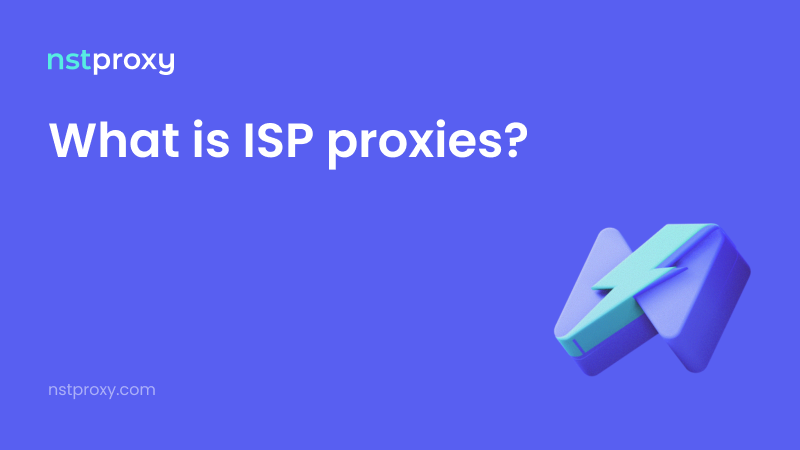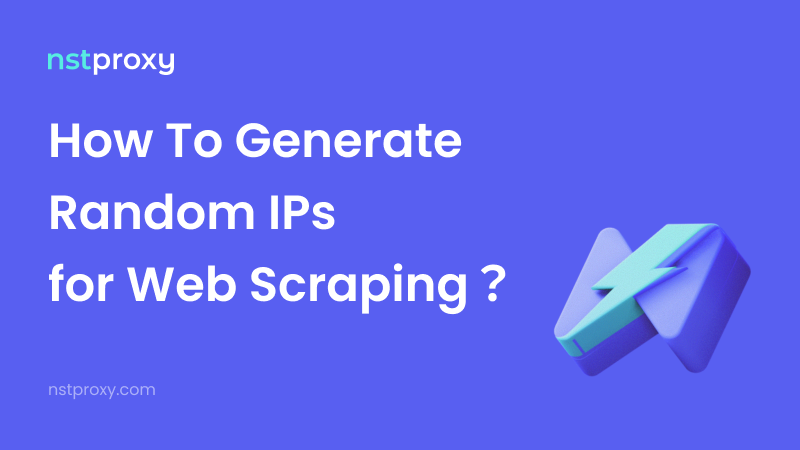Introduction
In modern Python network programming, HTTPX is rapidly becoming a powerful alternative to the Requests library, thanks to its excellent support for asynchronous requests and intuitive API design. However, for tasks like data scraping, API testing, or automation, facing increasingly strict anti-scraping mechanisms and geo-restrictions, using HTTPX alone is insufficient. Combining it with high-performance proxy services, especially platforms like Nstproxy that offer diverse and highly stable IP resources, is key to achieving efficient and anonymous network requests. This article will delve into how HTTPX seamlessly integrates with Nstproxy proxies, from basic authentication to intelligent rotation, helping you easily navigate complex network environments and provide reliable data support for AI applications.
Why Choose HTTPX for Network Requests?
HTTPX is a modern HTTP client in Python that supports both synchronous and asynchronous requests, and provides comprehensive support for HTTP/1.1, HTTP/2, and WebSockets. Its API design is similar to the Requests library, making it easy for Requests users to get started quickly. HTTPX's asynchronous capabilities make it perform exceptionally well when handling a large number of concurrent requests, which is particularly important for web scraping and AI data preprocessing tasks that require rapid data acquisition. Furthermore, HTTPX offers more granular request control and response handling mechanisms, providing developers with greater flexibility.
The Importance of Proxies in HTTPX
When making network requests, your real IP address is the primary means by which websites identify and track you. Frequent requests or abnormal behavior can easily lead to your IP being blocked by target websites, thereby interrupting data collection tasks. Proxy servers are an effective means of hiding your real IP and circumventing blocks. By routing HTTPX requests through a proxy server, the target website will only see the proxy's IP address. This not only protects your privacy but also makes it possible to implement IP rotation and overcome geo-restrictions.
Nstproxy offers globally leading proxy services, with its vast IP pool and diverse proxy types, capable of providing stable and reliable IP support for HTTPX, ensuring your network requests proceed smoothly.
Practical Integration of HTTPX with Nstproxy Proxies
Integrating HTTPX with proxies is very straightforward, simply by specifying the proxies parameter in your requests. Nstproxy supports various proxy types and authentication methods, which will be detailed below.
1. Using Unauthenticated Proxies
For proxies that do not require a username and password, configuration is very simple. Nstproxy provides some public test proxies, but authenticated proxies are generally recommended for stability and security.
import httpx
NSTPROXY_USERNAME = "your_nstproxy_username"
NSTPROXY_PASSWORD = "your_nstproxy_password"
proxy_url = f"http://{NSTPROXY_USERNAME}:{NSTPROXY_PASSWORD}@gate.nstproxy.io:24125"
with httpx.Client(proxies=proxy_url) as client:
response = client.get("https://httpbin.io/ip")
print(response.text)2. Using Authenticated Proxies
Most of Nstproxy's high-quality proxies require authentication to ensure that only authorized users can use. Authentication information is typically embedded in the proxy URL in the format http://username:password@ip:port.
import httpx
# Replace with your Nstproxy authentication information
NSTPROXY_USERNAME = "your_nstproxy_username"
NSTPROXY_PASSWORD = "your_nstproxy_password"
# Example Nstproxy datacenter proxy entry point
proxy_url = f"http://{NSTPROXY_USERNAME}:{NSTPROXY_PASSWORD}@gate.nstproxy.io:24125" # Assuming gate.nstproxy.io:24125 as entry
with httpx.Client(proxies=proxy_url) as client:
response = client.get("https://httpbin.io/ip")
print(response.text)3. Implementing IP Rotation Proxies
To prevent a single IP from being blocked, IP rotation is crucial. Nstproxy offers intelligent IP rotation capabilities, allowing you to achieve automatic IP switching at the request level through its dynamic residential proxy entry, without the need for manual IP list maintenance.
import httpx
import asyncio
# Replace with your Nstproxy authentication information
NSTPROXY_USERNAME = "your_nstproxy_username"
NSTPROXY_PASSWORD = "your_nstproxy_password"
# Nstproxy's dynamic residential proxy entry point, automatically assigns a new IP for each request
dynamic_proxy_url = f"http://{NSTPROXY_USERNAME}:{NSTPROXY_PASSWORD}@gate.nstproxy.io:24125"
async def fetch_ip(client, url):
response = await client.get(url)
return response.text
async def main():
async with httpx.AsyncClient(proxies=dynamic_proxy_url) as client:
print("--- First Request --- ")
ip_info1 = await fetch_ip(client, "https://httpbin.io/ip")
print(ip_info1)
print("--- Second Request --- ")
ip_info2 = await fetch_ip(client, "https://httpbin.io/ip")
print(ip_info2)
if __name__ == "__main__":
asyncio.run(main())Through Nstproxy's dynamic proxy entry, each request will use a different IP address, greatly improving the success rate and anonymity of scraping tasks. This is invaluable for scenarios requiring large-scale, high-frequency data collection, such as market trend analysis or search engine optimization (SEO) monitoring.
Nstproxy: The Cornerstone for Building Resilient Network Requests
In practical applications, network environments are complex and ever-changing, and a single proxy strategy may not be able to handle all situations. Nstproxy provides a comprehensive solution for building resilient network requests, ensuring your tasks run stably under all circumstances.
- Residential Proxies: Nstproxy boasts tens of millions of real residential IPs, covering over 200 countries and regions worldwide. These IPs come from real user devices, offering extremely high anonymity and trustworthiness, making them the preferred choice for circumventing the strictest anti-scraping mechanisms, especially suitable for social media data scraping and price monitoring.
- ISP Proxies: Combining the speed of datacenter proxies with the stability of residential proxies, ISP proxies are an ideal choice for scenarios requiring high-speed, stable connections while maintaining high anonymity. They are static IPs but provided by ISPs, making them less likely to be identified as datacenter IPs, suitable for AI data collection tasks requiring long-term stable sessions.
- Datacenter Proxies: Offer extremely high speed and bandwidth, suitable for tasks where anonymity requirements are not high but speed and concurrency are critical, such as large-scale content distribution or CDN testing.
- IPv6 Proxies: With the increasing adoption of IPv6, Nstproxy provides IPv6 proxies, helping users access websites that only support IPv6 or are IPv6-friendly, offering a broader data source for AI training and effectively addressing IPv4 address exhaustion.
- Flexible Billing Models: Nstproxy offers various billing options, including by traffic, by IP count, or by bandwidth, to meet the needs of different project scales and budgets, avoiding resource waste.
Case Study: Building a Failover Proxy Connection
When dealing with highly sensitive or unstable target websites, establishing a failover mechanism is crucial. For example, you can first try using a fast but potentially more easily detectable datacenter proxy, and if it fails, automatically switch to a more anonymous residential proxy.
import httpx
import asyncio
# Replace with your Nstproxy authentication information
NSTPROXY_USERNAME = "your_nstproxy_username"
NSTPROXY_PASSWORD = "your_nstproxy_password"
# Example Nstproxy datacenter and residential proxy entry points
datacenter_proxy = f"http://{NSTPROXY_USERNAME}:{NSTPROXY_PASSWORD}@gate.nstproxy.io:24125"
residential_proxy = f"http://{NSTPROXY_USERNAME}:{NSTPROXY_PASSWORD}@gate.nstproxy.io:24125"
async def safe_get(url: str):
# Attempt to use datacenter proxy first
try:
async with httpx.AsyncClient(proxies=datacenter_proxy, timeout=10) as client:
print("Attempting with datacenter proxy...")
response = await client.get(url)
response.raise_for_status() # Check HTTP status code
print("Datacenter proxy successful!")
return response
except httpx.RequestError as e:
print(f"Datacenter proxy failed: {e}")
except httpx.HTTPStatusError as e:
print(f"Datacenter proxy returned error status code: {e.response.status_code}")
# If datacenter proxy fails, attempt to use residential proxy
try:
async with httpx.AsyncClient(proxies=residential_proxy, timeout=30) as client:
print("Attempting with residential proxy...")
response = await client.get(url)
response.raise_for_status()
print("Residential proxy successful!")
return response
except httpx.RequestError as e:
print(f"Residential proxy failed: {e}")
except httpx.HTTPStatusError as e:
print(f"Residential proxy returned error status code: {e.response.status_code}")
print("All proxy attempts failed.")
return None
async def main():
target_url = "https://www.example.com" # Replace with your target URL
response = await safe_get(target_url)
if response:
print(f"Successfully retrieved content, status code: {response.status_code}")
# print(response.text[:500]) # Print partial content
if __name__ == "__main__":
asyncio.run(main())This example demonstrates how to leverage Nstproxy's different proxy types to build a robust failover mechanism, ensuring your tasks can still be completed successfully even when facing network fluctuations or upgraded anti-scraping measures from target websites.
Conclusion and Call to Action
HTTPX, as a modern Python network request library, combined with Nstproxy's powerful proxy services, can provide developers with unparalleled flexibility, efficiency, and anonymity. Whether it's simple unauthenticated proxies or complex authentication, rotation, and failover strategies, Nstproxy offers stable and reliable IP resources and technical support. With its massive IP pool, high stability, flexible billing, and diverse proxy types, Nstproxy is an ideal choice for your web scraping, market research, AI data collection, and other tasks. Integrate Nstproxy into your HTTPX projects today and experience unprecedented freedom in network requests.
👉 Register with Nstproxy now to unlock the full potential of HTTPX and take your data collection to the next level!
Key Takeaways
- HTTPX is a Modern Python HTTP Client: Supports synchronous/asynchronous, HTTP/2, suitable for high-concurrency requests.
- Proxies are Key to HTTPX Anonymity: Hides real IP, circumvents blocks, enables IP rotation.
- Nstproxy Offers Diverse Proxies: Residential, ISP, datacenter, IPv6 proxies, meeting various needs.
- Smart IP Rotation Simplifies Management: Nstproxy's dynamic proxy entry enables request-level automatic rotation.
- Build Resilient Failover: Combine different Nstproxy proxy types to improve request success rates and stability.
FAQ
Q1: What are the advantages of HTTPX compared to Requests?
A1: HTTPX supports both synchronous and asynchronous requests, has native support for HTTP/2 and WebSockets, and its API design is more modern, offering more granular control. This gives it an advantage over Requests when handling high-concurrency network tasks that require asynchronous operations.
Q2: How do Nstproxy's proxy services work with HTTPX's asynchronous features?
A2: Nstproxy's proxy services are fully compatible with HTTPX's asynchronous client (httpx.AsyncClient). You simply configure Nstproxy's proxy URL when creating an AsyncClient instance to achieve efficient proxy requests and IP rotation in an asynchronous environment.
Q3: How should I choose between Nstproxy's residential and ISP proxies for HTTPX?
A3: If your task requires extremely high anonymity and simulation of real user behavior, such as social media scraping, Nstproxy's residential proxies should be prioritized. If you need a high-speed and stable connection while maintaining high anonymity, such as for API data collection, ISP proxies are a better choice.
Q4: Does Nstproxy support HTTPX's streaming requests?
A4: Yes, HTTPX supports streaming requests, and Nstproxy's proxy services can be seamlessly integrated with HTTPX's streaming request functionality, suitable for scenarios involving large file downloads or real-time data streams.
Q5: How can I use Nstproxy to achieve geo-targeted proxies with HTTPX?
A5: Nstproxy provides geo-targeting capabilities. You can configure this in the Nstproxy control panel or specify the desired country, region, or city IP through specific proxy entry URL parameters. Then, configure the generated proxy URL in HTTPX to achieve precise geo-targeted requests.


